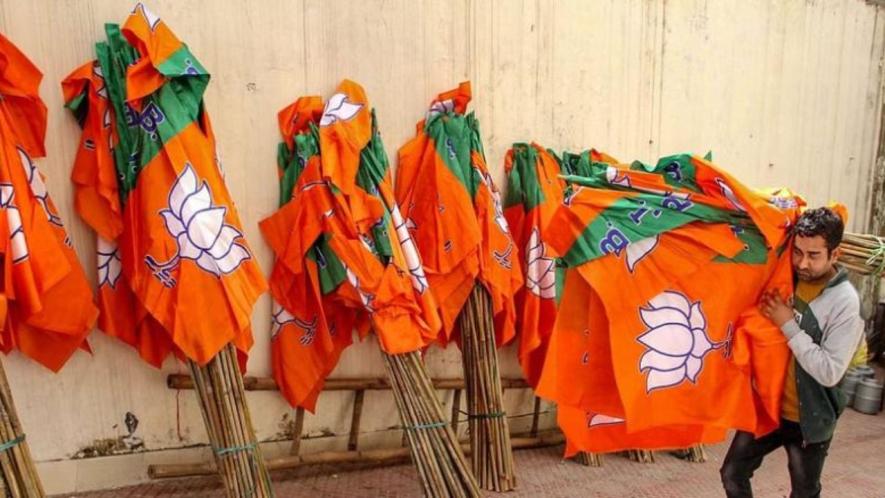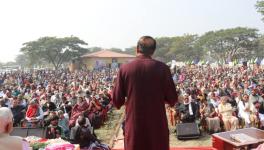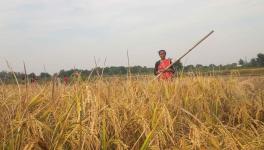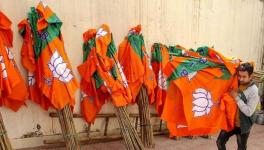Jharkhand: ‘Infiltration’ is BJP's Weapon; Next Bihar and Bengal?

Representational Image. Image Courtesy: PTI
There are three catch words -- Roti-Beti-Mati (Bread-Daughter-Land) --- around which the entire election campaign of the Bharatiya Janata Party (BJP) is revolving in Jharkhand. The saffron brigade claims that these three will be in danger during the rule of the opposition INDIA bloc, consisting of the Jharkhand Mukti Morcha (JMM), Congress and Rashtriya Janata Dal (RJD).
In meeting after meeting, Prime Minister Narendra Modi and Home Minister Amit Shah have been harping that ‘infiltrators’ from Bangladesh are “snatching bread, daughters and land” of the state’s original inhabitants. They are alleging that this is because of the support the “infiltrators” get from the JMM-Congress-RJD alliance government; the “intruders” are the vote banks of the INDIA bloc partners, they add.
Jharkhand was carved out of Bihar 24 years ago. During the Assembly election in the state, the Union minister Giriraj Singh organised a Hindu Swabhiman Yatra in his home state, Biha,r in the Seemanchal areas, i.e. the bordering districts of Bhagalpur, Purnea, Katihar, Araria, Madhepura and Kishanganj. In these northern districts of Bihar, the Muslim population is greater than in the remaining areas of the state.
Out of 10.41 crore population in Bihar, Muslims comprise 1.76 crore, i.e. 16.87%. In Purnea division (Seemanchal) it is 45.93%. The ruling Janata Dal United (JDU) led by Nitish Kumar, an ally of BJP, didn't make any secret of its feeling of anger over the programme of the Union minister. JD(U) had branded Giriraj Singh’s ‘yatra’ as an attempt to create a division much before Modi's Cabinet minister had embarked on the programme.
Meanwhile, Shah came and participated in a membership drive in West Bengal amid his busy election campaign schedule in Jharkhand. In his presence, Mithun Chakraborty, the recent Dadasaheb Phalke awardee, in a public meeting, threatened to bury Muslims under the ground, without, of course, naming them. The actor-turned-politician, who was earlier with the Trinamool Congress, is now a member of the core committee of Bengal BJP.
Chakraborty is quite adept in mouthing filmy dialogues in political platforms. In that meeting, he went on to say, “ln 2026, power will be ours and we’ll do whatever is required to be done to capture power. I’m saying this in the presence of the Home Minister --whatever is required to be done. And there is a likelihood of many hidden meanings in this ‘whatever....”
In Odisha, BJP has captured power on its own strength. The state was once among the three provinces of the Bengal Presidency, the other two being Bihar and Bengal. Moving southward along the coast of the Bay of Bengal, BJP has achieved this by dethroning the 25-year-old stable government of Bjiu Janata Dal led by Naveen Patnaik.
In Jharkhand (where Assembly elections are taking place), BJP has run an alliance government for 13 years, which came into being 24 years ago. But in Bihar, chief ministership has still eluded BJP, even though it is the bigger partner in the current Nitish Kumar alliance government.
With an aim to gain power with absolute majority in the Bihar Assembly elections one year hence, BJP has now targeted Seemanchal for its Hindu-Muslim polarisation agenda. Shah has, over the preceding two years, attended quite a few meetings in this area. The saffron brigade is trying to capitalise on the 53.51% Hindu vote in the area.
Interestingly, BJP has long been advocating the need for a separate Union territory along the border of Bihar and some districts in the northern part of West Bengal. According to the ruling party, this is necessary to form a Centrally-governed area to deal with China’s aggression.
Assam was once part of the Bengal Province under British rule. In 2016, the saffron brigade captured power in that North-Eastern state. Now, only West Bengal remains, where BJP has never tasted power. Across Bengal, the party has made inroads. However, it is amazing how the ruling TMC’s Mamata Banerjee who, day in and day out, blasts Narendra Modi, is now engaged in breaking the Left and Congress alliance and is creating political barriers to serve her political ends, thus making Bengal’s political field fertile for the growth of the saffron party. She claimed credit for defeating BJP in the 2024 Lok Sabha and 2021 Assembly elections. But the fact is that BJP has made deep inroads into Bengal during her regime. For her, the ideology-based politics of the Left and Congress seems far more dangerous than the communal and sectarian BJP.
It's quite clear from BJP’s election campaign in Jharkhand that the party is also conducting rehearsals for the electoral battles in Bihar and Bengal. After Jharkhand, it will move ahead with its plan to make “infiltration” a big issue in Bihar and Bengal.
The issue of infiltration has been an old weapon in the armoury of BJP. In election after election in the border states, such as West Bengal, Assam and Tripura, the party has always made this a major poll plank. Although, barring Assam, no other state has this strategy ever succeeded, with the infiltration weapon proving to be blunt.
Significantly, Modi and Shah, too, have made infiltration (from Bangladesh) the main weapon in this year's election in Jharkhand. Their speeches are similar to those made by them in West Bengal, Assam and Tripura earlier.
Countering the BJP campaign, Jharkhand Chief Minister and JMM leader Hemant Soren has raised a question as to why, while BJP carries out a shrill campaign on infiltration, has the Modi government given shelter to deposed Bangladesh Prime Minister Sheikh Hasina.
When Shah threatened to “hang the intruders upside down” after Hasina had taken shelter in India, the interim government of Bangladesh, led by Mohd Yunus, had lodged a strong protest.
The opposition INDIA bloc parties, on the other hand, questioned Modi-Shah “screaming” over the infiltration issue when it is they who have absolute control over border security agencies. What are Border Security Forces (BSF) doing? It is the Centre that is squarely responsible if there were intrusions from across the border, they said. The opposition also asked Modi-Shah why “intruders” were not being pushed back.
In Jharkhand, BJP's aim to make infiltration the main poll plank is because it is attempting to win over the Adivasis, who form 26% of the state’s population. Of the total 81 seats in the Assembly, 28 are reserved for the Scheduled Tribes. In the 2019 elections, BJP lost control of the state because of the rebellion by Adivasis.
The BJP government of Chief Minister Raghubar Das made amendments in the Tenancy Acts of Chotanagpur (1908) and Santhal Parganas (1949) and went ahead to hand over the land of Adivasis to non-Adivasis in the interest of industry and trade. Since then, the Adivasi community has been averse to the saffron camp. Although the government led by Das was the only one in 24 years, it could manage to complete five years.
But, in the face of severe anger of the Adivasis, even Das had to bite the dust. He lost his Jamshedpur East seat. Out of the total of 28 seats reserved for Adivasis, BJP could bag only two in the 2019 Assembly polls. On the other hand, JMM, led by Hemant Soren, promised to protect the land and rights of Adivasis, including government jobs on the basis of the domicile policy based on 1932 land records.
Now, after five years, BJP has made that very land as the only counter issue to win back Adivasis. They are alleging that their government became a victim of Adivasi wrath while trying to take land for industrial factories and development of trade, whereas during the five years of JMM-Congress-RJD rule, not only land, but the bread and livelihoods of the Adivasis have also been snatched by the “Bangladeshi infiltrators”. BJP is claiming that once back in power, intrusions would come to an end and the dispossessed land would be returned to the Adivasis.
Needless to say, the problem of infiltration in Jharkhand is not as big in reality as is being projected by the BJP. Moreover, a part of the populace at which the BJP's finger is being directed actually includes people from West Bengal, too. The inhabitants of Malda and Murshidabad in West Bengal, who have lost their homes and land due to erosion of the river Ganges, have shifted to the alluvial lands of Jharkhand and adjacent areas since quite a number of years. The fact that the majority of such people are Muslims has come in handy for the saffron camp for raising the issue of “infiltration”.
The fact, however, is that after issues like the court settlement on the Ram Temple land dispute, abrogation of Article 370 giving special status to Kashmir, or part enforcement of the Uniform Civil Code by imposing a law prohibiting triple talaq have outlived their relevance. There is no major plank in the hands of BJP to whip up Hindutva sentiments.
The Citizenship Amendment Act was not bought by the people. However, in comparison, infiltration is an issue that has the potential to be easily gulped by the people. It is said in Bengali that ‘purano chal bhate bare (bade)’, meaning old rice, when boiled, swells up more. BJP, therefore, is moving with the aim to utilise infiltration as an all-India issue.
The Bihar Angle
The Bihar Assembly elections are scheduled to be held in November next year. Many of the districts identified as Seemanchal border West Bengal and are also located at stone's throw distance from Bangladesh. In the 2024 Lok Sabha elections, the National Democratic Alliance (NDA) led by BJP was able to retain Araria only, losing the other three seats in the area, viz., Purnea, Katihar and Kishanganj. In this area, BJP is now fiercely vocal on the issue of so-called illegal immigrants from Bangladesh to arouse Hindu Swabhiman or sentiments.
In the areas of North Bihar, such as in the districts of Bhagalpur, Purnia and Katihar, many Bengali families have been living for generations. However, BJP is propagating that Bangladeshi immigrants have mixed themselves with the local Bengali populace. The same strategy was applied by them in Jharkhand where a large number of people from Bengal live, many of whom had actually shifted from erstwhile East Pakistan during Partition.
BJP's bid to polarize Hindu votes in Seemanchal is aimed with an eye on the Chief Minister’s seat on their own strength. On the other hand, the once-strong BJP base in Adivasi-inhabited areas in West Bengal has since weakened. Which is also the reason why the saffron brigade is making an issue of “dispossession of land” belonging to Adivasis in the hands of “infiltrators”.
The districts of Jangal Mahal, where the majority belongs to the ST community in West Bengal, are adjacent to Jharkhand, which is whyc the BJP’s campaign on the issue of infiltration in Jharkhand is receiving some response in these areas.
In addition, the recent change of guard in Bangladesh has made the task of the saffron camp easier for mingling the issue of terrorism with that of intrusions. It's not that during Hasina’s reign in Bangladesh, infiltration and terrorist activities had fully stopped. In fact, diplomatic compulsions have prompted the Modi government to adopt a strategy of not causing any embarrassment to Hasina in this matter. And now, after giving shelter to Hasina in India, Modi-Shah are raising their voices against Bangladesh on the issue of illegal immigration. Needless to say, the infiltration issue being raised by the Modi-Shah would be a major embarrassment for Sheikh Hasina, who is under their government’s shelter in the worst political crisis of her life.
Get the latest reports & analysis with people's perspective on Protests, movements & deep analytical videos, discussions of the current affairs in your Telegram app. Subscribe to NewsClick's Telegram channel & get Real-Time updates on stories, as they get published on our website.
























